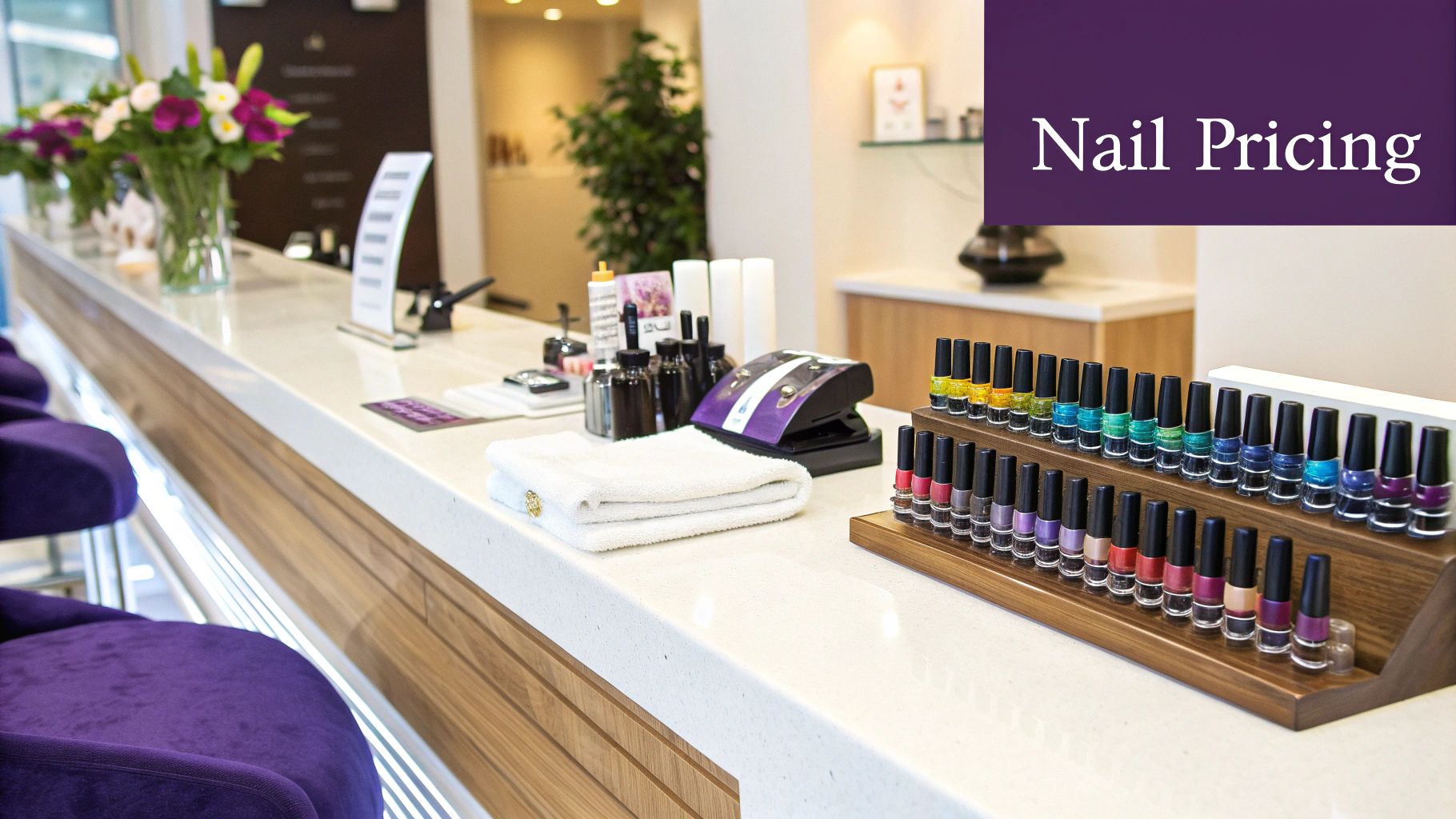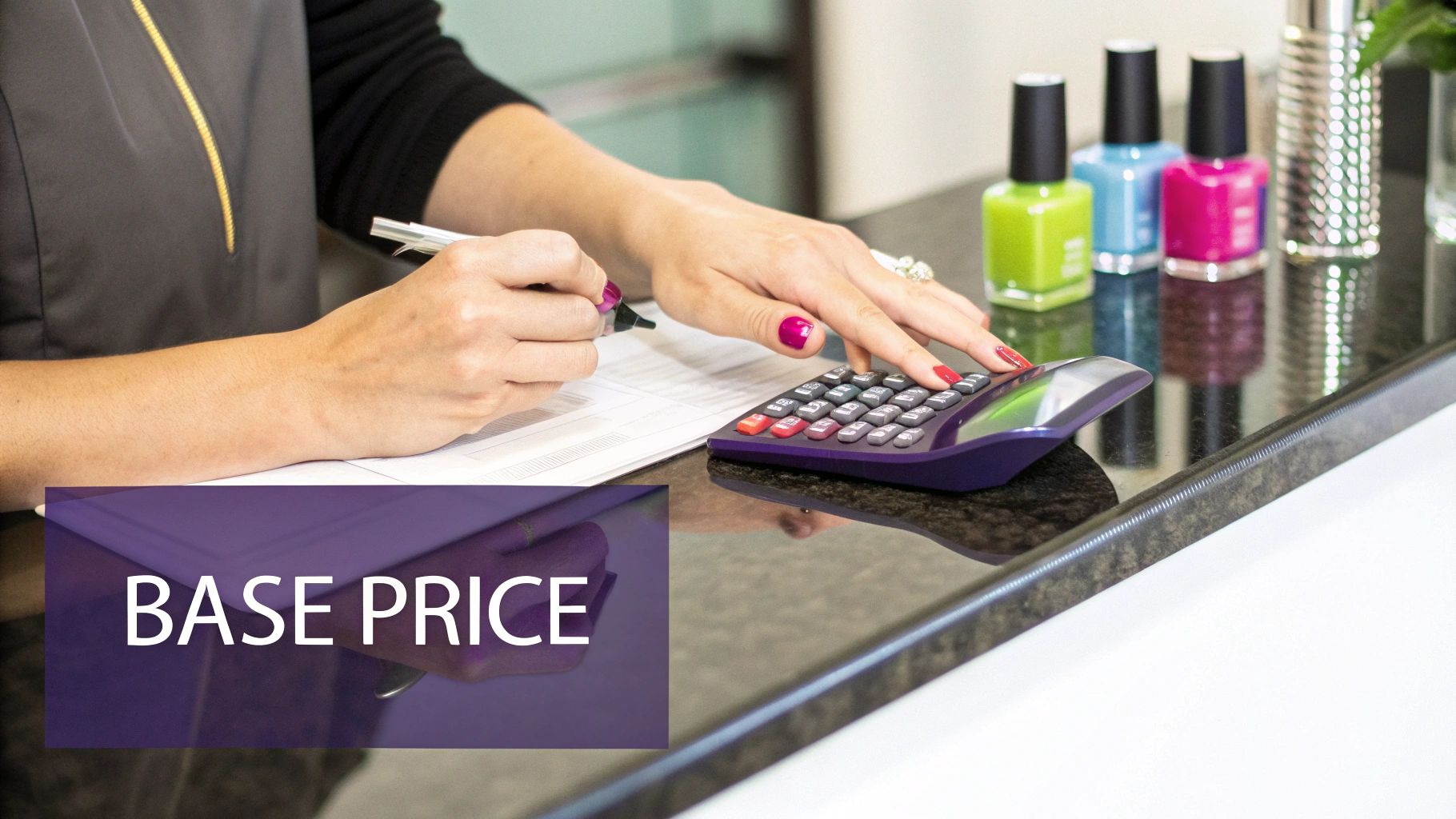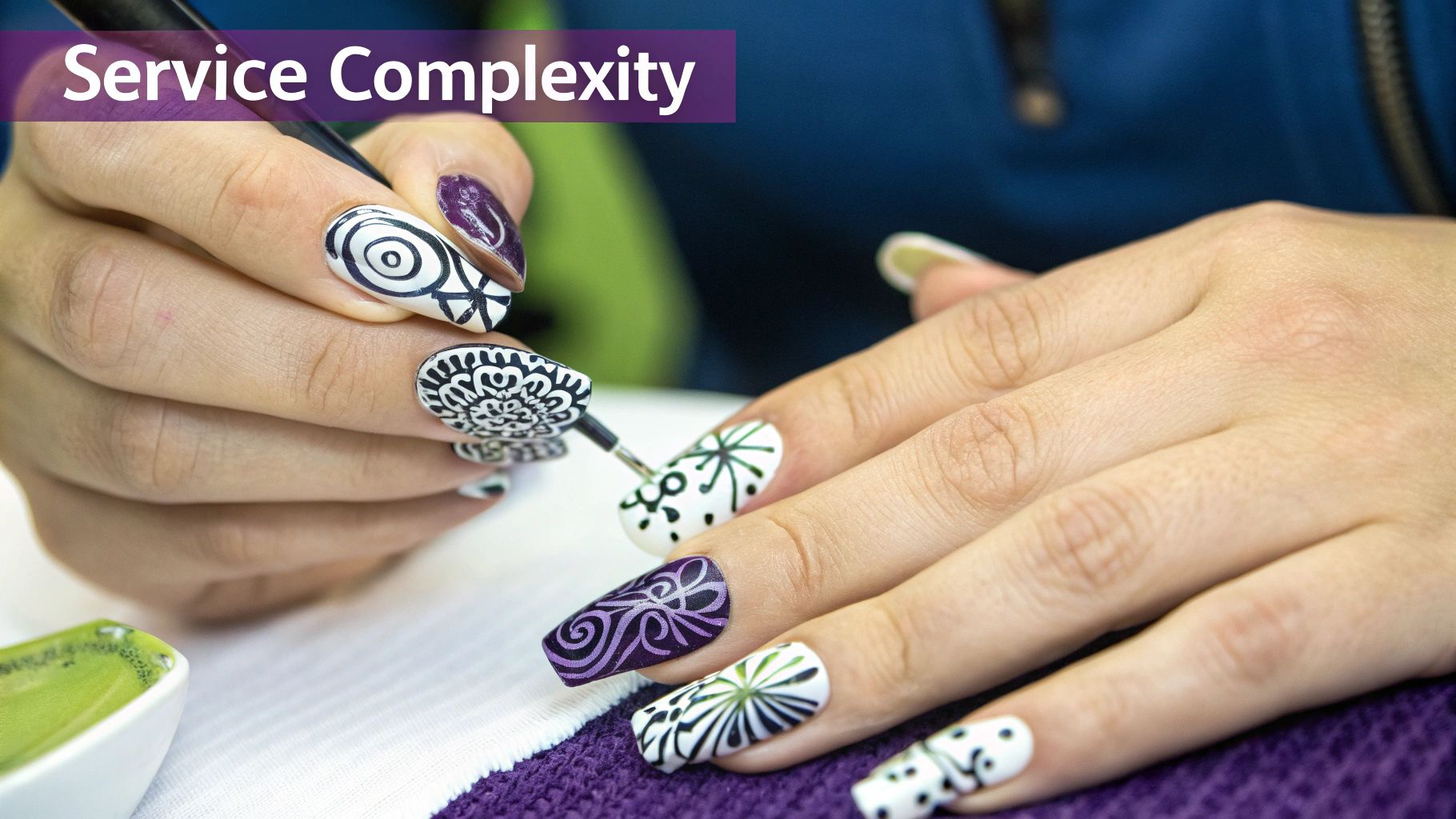How to Price Nail Services for Maximum Profit

Getting your nail service pricing right is one of the most critical parts of turning your passion into a profitable business. It’s not just about picking a number out of thin air; it’s a strategic decision that balances your costs, your market's value, and your unique expertise. This guide provides actionable steps to set prices that cover your expenses, attract your ideal clients, and build a sustainable career you love.
Finding Your Salon's Pricing Sweet Spot
Figuring out how to price your nail services can feel like walking a tightrope. Price too high, and you might scare away potential clients. Price too low, and you undervalue your skills, leading to burnout and leaving money on the table.
This guide will walk you through a practical, step-by-step approach to finding that perfect balance. Instead of just copying the salon down the street or competing on price, you'll learn to build a pricing strategy that reflects your true business costs, your level of expertise, and the unique experience you offer. Once you understand these elements, you can set your prices with total confidence.

Why Strategic Pricing Matters More Than Ever
The nail industry is booming. The global nail salon market was valued at around $11 billion in 2022 and is projected to reach $20.3 billion by 2030. This incredible growth means more opportunity, but it also means more competition. A smart pricing strategy is your key to standing out.
A smart pricing strategy does more than just pay the bills. It’s a powerful tool that communicates your value, attracts your dream clientele, and funds your professional growth—from advanced nail art classes to investing in higher-quality products.
A strategic approach to pricing is essential for long-term success. It empowers you to:
- Cover All Your Costs: Go beyond polish and acetone. Factor in everything: rent, utilities, marketing, insurance, and—most importantly—your own salary.
- Guarantee Profitability: Ensure every appointment contributes to your bottom line. Profit allows you to reinvest in your business and grow. Learn more about improving your beauty salon profit margins.
- Position Your Brand: Your prices tell a story about your quality, expertise, and the client experience you provide.
- Avoid Burnout: Fair compensation for your time and talent prevents the financial stress that grinds so many artists down, keeping you passionate about your craft.
Your Nail Service Pricing Checklist
Before you calculate, use this checklist to understand all the components of a solid pricing structure. This framework ensures you don't miss any crucial details.
| Pricing Component | What It Includes | Why It Matters for Profit |
|---|---|---|
| Product Costs | Polish, gels, acrylics, nail art supplies, top coats, files, cuticle oil, disposables. | These are your direct costs per service. Miscalculating them means you could be losing money on every client. |
| Overhead Expenses | Rent/mortgage, utilities, insurance, booking software, marketing, taxes, licenses, and professional fees. | These are the hidden costs of running a business. Spreading them across your services ensures your prices actually cover them. |
| Your Time & Labor | The time spent on the actual service, plus prep and cleanup. Crucially, this includes your desired salary. | Your time is your most valuable asset. If you don't pay yourself a fair wage, you're working for free. |
| Market Rates | What other reputable nail techs in your local area with similar skill levels and offerings are charging. | This provides a baseline and helps you position your brand effectively, whether you aim to be mid-range, premium, or luxury. |
| Profit Margin | The extra percentage you add on top of all your costs. This is what allows your business to grow. | Profit isn't a dirty word! It's the money you use to invest in new equipment, training, and a better client experience. |
By systematically working through each component, you’re not just guessing at a price—you’re building a sustainable business model from the ground up.
Figuring Out Your True Cost Per Service
To master your nail service pricing, you must know your numbers inside and out. Profitability starts by calculating the actual cost of every service you offer. This includes not just the products you use but also the hidden expenses that keep your business running.
The most obvious part is your direct material costs—the tangible products consumed during an appointment, from cuticle oil to foil wraps. While these seem small individually, they add up significantly over a month of clients.
This breakdown shows you exactly what components you need to be tracking.

As you can see, a truly profitable price is built by layering your material costs, your valuable time, and a slice of your business overheads.
Calculating Your Baseline Cost
To find your baseline, follow this simple, actionable formula.
Step 1: Calculate Your Monthly Overhead. Add up all the fixed expenses you pay to operate your business.
- Rent or mortgage for your salon space
- Utilities like electricity, water, and Wi-Fi
- Software subscriptions (like Fresha or Vagaro)
- Business insurance and professional licenses
- Marketing costs and professional fees
Step 2: Determine Your Hourly Overhead Cost. Divide your total monthly overhead by the number of hours you plan to work in a month.
- Example: If your overhead is $1,200 a month and you work 100 hours, your hourly overhead cost is $12 per hour ($1200 / 100).
Step 3: Calculate Your Baseline Cost Per Hour. This is your break-even point—the absolute minimum you must earn per hour.
- Formula: Hourly Overhead Cost + Your Desired Hourly Wage = Baseline Cost Per Hour.
- Example: $12 (overhead) + $30 (wage) = $42 per hour.
Step 4: Determine the True Cost of a Service. Add the material cost for a specific service to your baseline cost, adjusted for the time it takes.
- Example: If a gel manicure takes one hour and uses $3 in products, your true cost for that service is $45 ($42 baseline + $3 materials). This is the number you will add your profit margin to.
Industry costs are always changing. The COVID-19 pandemic, for example, forced salons to adjust prices to cover new health and safety expenses. Staying informed on global nail salon strategies helps you adapt to these market shifts.
Scope Out Your Local Market and Competition
Knowing your numbers is critical, but it's only one piece of the puzzle. Now, you need to research your local nail scene to understand where you fit in. This isn't about copying competitors; it's about gathering intelligence to position your brand effectively. Learning how to conduct market research is a vital business skill.

Run a Strategic Competitor Audit
Here’s a clear action plan for analyzing your competition:
Step 1: Identify 5-7 Competitors. Create a list of other nail professionals in your area, including a mix of different business types:
- The Budget-Friendly Spot: The fast, walk-in salon known for low prices.
- The Mid-Range Favorite: The popular, reputable salon with a loyal client base.
- The Niche Specialist: The go-to artist for complex, hand-painted designs.
- The Luxury Experience: The high-end spa that sells a premium, relaxing atmosphere.
Step 2: Analyze Their Value Proposition. Go beyond just their price list. Investigate what clients are really paying for.
- Read their online reviews (the good and the bad).
- Analyze how they describe their services on their website and social media.
- Ask yourself what makes each one unique. Is it their use of non-toxic products? Their seamless online booking? The relaxing client experience?
Don’t just look at what your competitors charge; investigate why they can charge it. The answer reveals what your local market truly values, whether it's convenience, artistry, luxury, or a personal connection.
This research will give you the insight to confidently price your services based on the unique value you offer, whether you're the expert in structured manicures or the artist creating one-of-a-kind wearable art.
Designing a Profitable Service Menu
Your service menu is a powerful sales tool. When designed strategically, it guides clients toward higher-value services, increases your average ticket price, and boosts your overall profitability. The key is to create a clear, compelling journey for your clients that naturally encourages upselling.

Tiered Pricing and Smart Add-Ons
One of the most effective strategies is tiered pricing. This involves grouping services into different levels, such as 'Classic,' 'Luxe,' and 'Ultimate' packages. Each tier builds on the last, adding more value to justify the higher price. For example, a 'Luxe' pedicure might include an exfoliating scrub and hot towel wrap that the 'Classic' version doesn't.
Combine this with an a la carte menu for add-ons to give clients control while increasing your revenue. Actionable examples include:
- Complex Nail Art: Price per nail or in 15-minute time blocks for intricate work.
- Paraffin Treatment: Offer as a simple, high-margin luxury upgrade.
- Gel Polish Removal: List as a separate service if it's not included in the base price.
Your menu’s goal is to make your premium offerings feel like an irresistible upgrade, not just a higher cost. It's about showcasing the value of the experience you provide.
The design of your menu is also crucial. Look into effective menu board design ideas to spotlight premium services and present your prices attractively. A well-designed menu is a key part of your nail salon business plan.
Sample Nail Service Pricing Tiers
Here is a sample table to help you visualize a tiered structure. This model makes it easy for clients to see the value in upgrading.
| Service Tier | Services Included | Example Price Range | Key Upsell Opportunity |
|---|---|---|---|
| Classic | Basic manicure/pedicure, shape, buff, polish | $25 – $40 | Upgrade to gel polish or add a simple nail art design. |
| Luxe | All Classic services + scrub, mask, hot towels | $45 – $65 | Add a paraffin wax treatment or extended massage. |
| Ultimate | All Luxe services + extended massage, paraffin | $70 – $95+ | Introduce premium, non-toxic polishes or complex art. |
This tiered approach gives clients options that feel tailored to their needs, whether they want a quick refresh or a full pampering session. It also allows you to capitalize on market trends. For example, the growing demand for non-toxic products can justify a 10-20% price increase for those services, while nail art can add $10-$25 or more to your ticket.
Talking Price and Value with Your Clients
You've done the math and created a solid pricing strategy. Now comes the crucial part: communicating it with confidence. How you present your prices sets the tone for the entire client relationship, turning a simple transaction into an investment in your expertise.
The first rule is transparency. A professional, easy-to-find price list on your website and in your salon is non-negotiable. It eliminates awkward conversations and sets clear expectations from the start. Clients appreciate knowing the cost upfront.
Justifying Price Adjustments Without the Guilt
Price increases are a normal and necessary part of running a business. Instead of feeling apologetic, view it as an opportunity to reinforce your value. The key is to frame the change around the benefits to your clients.
When you announce an update, focus on the positive investments you’re making in their experience. Use these actionable talking points:
- "So I can continue investing in advanced nail art education and bring you the hottest new techniques, my service prices will be updated on [Date]."
- "I'm so excited to be switching to a new line of premium, long-lasting gel products! To accommodate this amazing upgrade, there will be a small price adjustment starting on [Date]."
This approach shows clients that the increase directly translates to a better service for them.
Remember, clients aren't just paying for polish and an hour of your time. They're paying for your skill, your endless hours of education, and the top-tier products you've carefully selected. Own your worth and communicate it.
Confident communication builds trust. When your clients understand the why behind your prices, they see it as a worthwhile investment in quality care from a dedicated professional. This is how you build loyalty and attract clients who value true expertise.
Common Questions About Pricing Nail Services
Even with a solid strategy, you'll face common pricing challenges. Knowing how to handle these situations with confidence will keep your business thriving. Here are actionable answers to frequent questions.
One of the biggest questions is how often you should review your prices. Actionable Rule: Conduct a full pricing review at least once a year. This allows you to adjust for inflation, rising supply costs, and your own skill development. However, don't wait for an annual review if a major expense changes. If your rent increases or a key product line has a price hike, reassess your pricing immediately.
Announcing Price Changes Gracefully
Telling clients about a price increase can feel uncomfortable, but transparency makes it manageable.
Action Plan for Announcing Changes:
- Give Advance Notice: Inform clients at least 4-6 weeks before the new prices take effect.
- Communicate on All Channels: Post a polite, professional notice at your station, on your booking site, and on your social media.
- Frame with Confidence: Focus on value, not apologies. Use a script like: "To continue using the highest quality products and investing in advanced education, my service prices will be updated on [Date]. I'm excited to keep bringing you the best experience possible!"
This approach reminds clients they are paying for premium quality and expertise.
Pricing New and Trendy Services
When a new trend like chrome powders or 3D art explodes, you need a quick and effective pricing method.
Action Plan for Pricing Trends:
- Calculate Costs: Determine the exact product cost for the new service and, crucially, how much extra time it will take you.
- Research the Market: See what other respected techs in your area are charging for similar advanced work to find a competitive price point.
- Structure as an Add-On: Price specialized services as add-ons to your base menu. This keeps your menu clean and makes pricing clear for clients.
Example Add-On Menu:
- Simple Art (dots, lines): +$5 per nail
- Complex Design (characters, chrome): +$20 per 30 minutes of detailed work
This method ensures you're compensated fairly for your time and artistic talent. If you're just getting started, our guide on how to start a nail salon offers more foundational business tips.
Ready to showcase your perfectly priced services with a stunning online presence? At gohappybeauty, we build beautiful, SEO-optimized websites designed specifically for nail artists like you. Get your professional salon website today!
Grow your beauty business
Our focus is, and always will be, helping you improve your online presence and generate more business from your website. That is what we do, for you.

